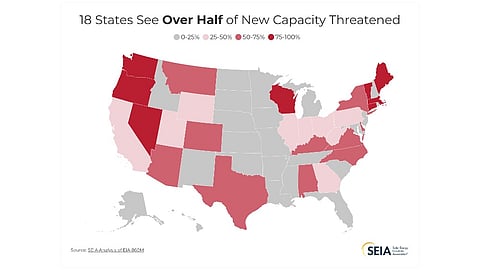

Over 116 GW of solar and storage projects across 44 US states face uncertainty due to heightened federal scrutiny and permitting delays, says SEIA
The Trump administration’s policies have tightened approvals, stalling even fully permitted renewable projects
Texas leads with 40% of at-risk capacity, while SEIA warns stalled projects could drive up power costs and grid instability
Over 500 solar and storage projects totaling 116 GW capacity or more than half of all new power capacity planned to be built in the US through 2030, are under threat, due to growing political attacks on renewable energy in the country, according to the Solar Energy Industries Association (SEIA).
Referring to data from the Energy Information Administration (EIA), SEIA says 73 GW of solar and 43 GW of storage projects, spread across 44 states, are yet to receive the requisite permits. These are at risk of being ‘targeted’ by the administration. Their loss could mean 18 states could lose half of all their planned capacity, including Texas, Virginia, Arizona, and Nevada. Texas alone accounts for nearly 40% of the at-risk projects.
“They represent the heart of America’s energy future and are critical to meeting soaring demand and keeping prices affordable,” claims the solar trade body in a new report.
According to the association, developers that have already secured zoning approvals, completed environmental studies, and worked with local communities are now unable to move forward as they need to consult with federal agencies before beginning construction.
Under the One Big Beautiful Bill Act (OBBBA), the Trump administration has tightened permitting and tax credits for wind and solar energy in the country. It has also increased scrutiny for such projects by the Department of the Interior, while terminating funding for clean energy (see Elevated US Federal Scrutiny For Wind & Solar Energy Projects).
Many projects are stuck in limbo under Washington’s new energy permitting system, including solar and storage projects on private land now caught up in multiple federal reviews, says the association.
It adds, “This federal overreach erodes private property rights and local decision-making, inserting Washington bureaucrats into projects that landowners and communities want to host.”
“If these projects can’t move forward, customers will be forced to compete for a shrinking supply of electricity. That means higher prices and a destabilized grid,” warns the association.
However, the EIA recently said that in Q3 2025, solar projects representing about 20% of planned capacity reported a delay, a decrease from 25% in Q3 2024, and that delays in bringing these projects into operation have been trending downward in recent months.
Calling solar and storage the quickest way to add new power at scale, accounting for 84% of new capacity in 2024 and 71% of planned capacity buildout, the SEIA argues that these technologies offer fast, affordable generation to meet the growing electricity demand from AI, data centers, and manufacturing.
Recently, a Permit Power report said that close to 20 million more US families can benefit from 198 GW more rooftop solar by 2040 if there is an easing of regulations (see US: Cutting Red Tape Could Add 198 GW More Rooftop Solar By 2040).
